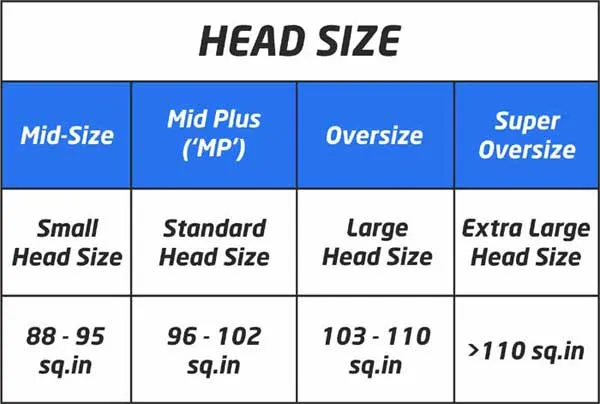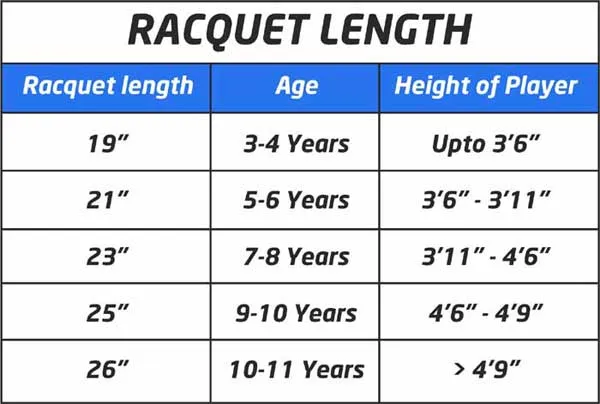JavaScript seems to be disabled in your browser. For the best experience on our site, be sure to turn on Javascript in your browser.
Tennis Racquets Buyer's Guide
15 Tips for Buying the Right Tennis Racquet – The Definite Guide
To assist you in a better way, we are providing you our Tennis Racquets Buyer's Guide. In this buyer's guide, you can understand the basic concepts of our racquet’s specifications & features. At Racquets4u, you can choose a tennis racquet according to your grip size, head size, length, weight and many more, which can help you in a better purchase decision.
I) Racquets according to Play Level:
If you are a beginner, intermediate or advanced player, then select the racquet according to your play level only. You can also go through the below specifications to understand more about racquet features.
- Professional Level Racquets: These racquets are well-suitable for those players who play competitive tennis and love to create their power. These racquets come with heavy frames, head-light balance & medium-sized head. Buy professional tennis racquets.
- Intermediate Level Racquets: These kinds of racquets come with medium-weight, moderately head-light & almost larger head sizes. These racquets offer a great combination of both power and control. Buy tennis racquets for intermediate players.
- Beginner Level Racquets: If you have a beginner or just started playing tennis then you should select that racquet that is light in weight for easier swing with more power. Racquets with an oversize head and head-heavy balance are superior for both beginner and recreational players. Buy tennis racquets for beginners.
- Junior Level Racquets: These racquets are specially made for kids aging b/w 3 - 12 yrs. These racquets differ in length as per our kids age. To be specific one should choose – 17 or 19 inch racquet for children up to 3yrs, 21 inch for 4-6 yrs, 23 inch for 7-8 yrs, 25 inch for 9-10 yrs and 26 inch for 11-12 yrs. Buy junior tennis racquets.
II) Power vs Control Racquets: Which racquet is more superior for me?
Players often require racquets that suits their playing style, which can provide them more power & control in their shots and blend. You can read the below classification & features of racquets along with examples for better assistance in easy selection of racquet.
- Power Racquets: These are lightweight racquets that come with features like oversized head, heady-heavy & even-balanced. Specially designed for those players who are looking for extra power in serves along with shorter swings. E.g. HEAD 360 Speed, HEAD Touch Speed.
- Tweener Racquets: This type of racquets is well-suitable for both intermediate and advanced players & for those also who are looking for a combination of both power and control. These racquets are light in weight along with a good balanced between little head-light to little head-heavy, and Mid-plus heads. E.g. HEAD 360+ Gravity, Babolat Pure Aero Team, Babolat Pure Drive Plus, HEAD 360 Instinct, Head YOUTEK IG Radical MP, Yonex Ezone 100 Racquet, HEAD 360 Extreme.
- Control Racquets: These racquets are ideal for professional and advanced players who play both tournaments and competitions. These racquets are heavier in weight along with smaller heads, thinner beams, and head-light balance for more maneuverability. These racquets help in hitting longer & powerful swings. E.g. HEAD 360 Radical Pro, Babolat Pure Strike, Wilson Pro Staff, Wilson Blade 98, Head Touch Graphene Radical MP, Yonex Ezone 98 Racquet.
III) What should be the weight of my racquet?
The average weight of tennis racquets varies in between from 270gm to 300gm (unstrung). At racquets4u.com, we have a huge variety of racquets with different weight ranges.
- Light-weight racquets (225-275 gm): These racquets are ideal for those players who are looking for extra power in their serves along with shorter swings. Beginners can select either light-weight or medium-weight racquets for themselves.
- Medium weight racquets (276-300 gm): These racquets are ideal for both club players or intermediate level players. These racquets come with a great combination of both power & control to improve your performance in a game.
- Heavier racquets (>300gm): These racquets are superior for advanced players. Players can generate their own pace with more control in their shots.
IV) What should be the balance point in a racquet?
‘Balance point’ in a racquet refers to the weight distribution of the racquets. In other words, the balance point can be determined by where the center of balance lies in the racquets, starting from the base of the handle. Mainly, there are three categories of balance in any tennis racquet:
- Head-heavy Racquets (345-370mm): These racquets offer power & stability to the lighter. The distribution of the weight of racquets moved from handle to frame head i.e. main hitting area.
- Head-light Racquets (290-320mm): These racquets are well-suitable for advanced players who are looking for extra power. These racquets are ideal for those players who either looking for good control or play at the nets. These racquets add maneuverability to heavy frames.
- Even-balanced Racquets (320-345mm): These racquets are ideal for all-court players by providing good power for baseline play and superior maneuverability at nets. These racquets offer great feel & flexibility to the players. The distribution of weight is across the racquets.
Note: The addition of a string increases the weight of the racquet's head by approx. 4-18 gm. The addition of a grip to the racquets handle increases the weight towards the handle and reduces the balance point.
V) What Head size should I select for my racquet?
A larger head size racquet is more suitable for both beginners & intermediate players, offers more surface area for the ball to come in direct contact with the string. This variety of racquets provides a larger ‘sweet spot’ with additional power. A smaller head size racquet is best for experienced players & provides more control over the racquet. Below check the table contents of head size for better tennis racquet selection:

VI) What should be a suitable racquet length for me?
For adult players, the standard length of the racquet is 27”. For junior players, the length of the racquet is 26". Longer racquets (‘+’ version) are also available with more than 27.25” or the same length helps in covering the more area on the court. These longer racquets offer more power in serves. Below check the table contents of racquet length for better tennis racquet selection:

VII) Which should be the grip size of my tennis racquet?
The standard grip size of a tennis racquet is 4 3/8”. We also provide some extra smaller and bigger grip sizes. If you want to check your grip size then you should place your ruler in the middle of your palm & measure the distance between the intersection of the thumb and fingers straight up to the top of the ring finger. In case, if you are unsure between these two grip sizes then always choose the smaller grip size and add an overgrip after that which can suit to your game.
VIII) What is Beam thickness?
The thicker the beam, the more power will be provided by the racquets.
- Control racquets are 18 - 21 mm.
- In-between racquets are 23 - 27 mm.
- Power racquets are 28 mm and above.
IX) What is the composition of the different materials of racquets?
Different brands have their own material composition specifications. Mainly, tennis racquets are available in three types of composition:
- Aluminum: These racquets are good and affordable for beginners. These types of racquets are heavier than the others.
- Graphite Composite: These racquets are perfect for recreational players or for those who are looking for the lesser-priced racquet. These racquets come with a combination of Graphite and other materials like Titanium, Kevlar, etc & lighter than aluminum.
- Pure Graphite: These racquets are ideal for both intermediate and advanced players. These racquets made from 100% Graphite & are expensive. These racquets are light-weight and generate powerful swing.
X) What is Stiffness or Flex?
Resistance to deflection is known as flex. Whenever the ball hits the racquet, the impact of the ball makes the frame bend or ‘deflect’. Mostly racquets fall in the 50-75 range with higher numbers signifies which provides more stiffness. Racquets which are more flexible, bend more on impact. Racquets with stiffer frames, deflect less, and less power on the impact of the ball. However, stiffer frames provide more power than flexible ones but these are less comfortable.
XI) What is the impact of various string patterns on tennis racquets?
- An open pattern of 16 mains x 15 crosses (or less) provides more spin with bigger spaces so that string bites can go deeply into the ball. E.g. Wilson Pro Staff 95S Racquet.
- A denser pattern of 16 mains x 19 crosses offers less spin but provides more control. E.g. Wilson Pro Staff 95 Racquet.
XII) What is String Gauge?
String Gauge is the thickness of a string that varies from a range of15 gauge (thickest) to 18 gauge (thinnest). Thinner strings are less durable but provide more feel and control.
XIII) Why some tennis racquets are unstrung?
- Junior, beginner, and recreational racquets are mostly pre-strung at an average tension.
- Intermediate and advanced racquets come in unstrung condition and getting it strung at a tension conducive to their playing style. These racquets provide a good choice to the players for choosing their desired string.
XIV) Which string should I choose for my racquet?
One can play with different strings to optimize the combination of both power and control according to your style and play. The primary string types are given below:
Synthetic Strings: These are the most commonly used string & made up of polymer & highly-durable.
- This can be of the multifilament type which provides more power and comfort to the players. This string comes with hundreds of micro-fibers wrapped together. E.g. Luxilon ALU Power String.
- Monofilament strings come with a solid single-core design which provides more durability than the multifilament variety, along with more comfort and spin. E.g. HEAD Hawk Touch, Babolat RPM Blast, Solinco Outlast 16
Professional players use Natural gut which is quite expensive but provides the best power and extreme comfort to them. E.g. Babolat VS Team.
Some players prefer a hybrid one string blend which provides extra durability & flexibility in their strings. This offers more durability & flexibility to the players. E.g. HEAD Gravity.
XV) At what tension should I get the racquet strung?
How the racquets string interacts with the ball is more important and thus it is necessary that the tension at which the racquets should be strung should be according to your game & level of style. The average string tension lies in between the range of 55 - 58 lbs. for a balance of power and control in the racquet.
- Higher Tension: If you are an advanced player then all you need is only higher tension in the racquets. It is ideal for those advanced players for whom precision and control are the most important. These racquets strung at high tension of 59 lbs. or more.
- Lower tension: Either you are a beginner or intermediate player then all you need is lower tension in the racquet. It provides more power in the shots like a spring effect. Beginners should get their racquets strung at low tension at around 55 lbs.


